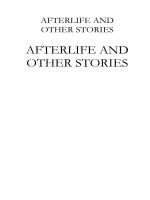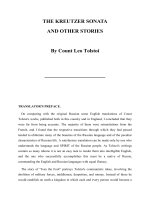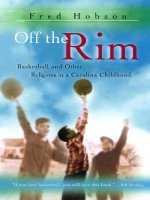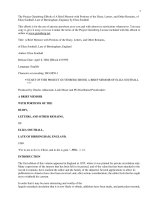The angry sea and other stories
Bạn đang xem bản rút gọn của tài liệu. Xem và tải ngay bản đầy đủ của tài liệu tại đây (6.4 MB, 130 trang )
Reading
AND OTHER STORIES
i-
AW1RY SEA
AND OTHER STORIES
Reading
and
Exercise
Series
The Whistler
The Angry Sea
Winds of Virtue
The Quiet Man
The Monkey’s Paw
Tale from Tangier
Reading
& Exercise
Series
ANCRY SEA
AND OTHER STORIES
Adaptations and exercises by Jean N. Dale
Edited by Willard D. Sheeler
This book is co-distributed in the United States of America by
English Language Services, Inc. and Oxford University Press, Inc.
Copyright © 1973, 1975
English Language Services, Inc.
Printing
4
5
6
7
8
9
10
All rights reserved. No part of this book may be reproduced
or transmitted in any form or by any means, electronic or
mechanical, including photocopying, recording or by any
information storage and retrieval system, without permis¬
sion in advance in writing from the publisher, English
Language Services, Inc.
Cover design by Mark Fristad
Cover illustration by Jerry Werner
Text design by John Eccles
Illustrated by Loren Weeks
Acknowledgment is made for permission to print
adaptations of the following:
“No Circus Today," was based on material from Clown by Emmett Kelly.
Copyright 1943. Reprinted by permission of Prentice-Hall, Inc.
“The Angry Sea,” by Virginia H. Maas
“The Rocking Chair,” by Pat Cornay
"It Happened on Maple Street,” an adaptation of “The Monsters are Due
on Maple Street," by Rod Serling. Copyright 1960 by Rod Serling.
Reprinted by permission of Bantam Books.
ISBN 0-89285-051-5
Printed in the United States ot America
preface
The Angry Sea is the second of six books in the Reading and
Exercise Series, designed for students of English as a second
language. Each of the six stories in this reader is followed by
exercise material which can be profitably used to help the student
improve his reading skills. Vocabulary lists and answer keys are
provided. Suggestions for using the reader are given in the
Introduction for the Teacher.
The Reading and Exercise Series is designed for use as
supplementary material to most basic textbooks. Students using
Welcome to English will find that The Angry Sea is appropriate
for Books 3 and 4. The stories are prepared for students working a
little beyond the elementary level and are thematically of interest
to adults and young adults.
The tape recordings that accompany this series provide a
valuable opportunity for the student to hear language in use. The
tapes present a variety of native American voices, both male and
female.
introduction
for the teacher
The Angry Sea consists of six stories with accompanying
exercises which are an integral part of the book. It is designed to
be used as supplementary reading material either in conjunction
with Welcome to English or with other basic texts.
Supplementary reading material may be used to reinforce
known structures, or simply to provide enjoyment and to give the
student a sense of accomplishment that will encourage him to read
more extensively. Supplementary readings are generally offered
without time pressure and without detailed discussion of the
language structure. The readings should not be so difficult for the
student that they produce frustration.
To this end, we have limited the vocabulary load and used only
a selected number of grammatical structures.
Vocabulary. Following each story, certain words from the
reading selection are isolated and defined contextually; many are
illustrated.
This vocabulary section can be used to pre-teach vocabulary
items before having the students read the story. It is a matter of the
teacher’s
preference
and
experience
whether
to
pre-teach
vocabulary or to wait until after the reading and work with only
those items causing difficulty. Many words which are likely to
cause difficulty are explained or defined within the story itself.
The illustrations, too, can be an aid in explaining certain
vocabulary items.
The words selected for study are those which are “new” in the
sense that they have not occurred in preceding units of Welcome
to English. Word lists broken down by parts of speech are at the
back of the book, together with a cumulative word list.
Structure. Structures emphasized in the readings are listed in
the Table of Contents. They are presented in Welcome to English,
Book 3 and the first three units of Book 4. For teachers using this
vii
series, the following table shows at what point the stories should
be assigned for reading.
Ask Your Husband
Circus Time
No Circus Today
The Rocking Chair
Welcome to English, Book 3
Unit 1
Unit 2
Unit 3
Unit 7
Welcome to English, Book 4
It Happened on Maple Street,
Unit 1
Part 1
It Happened on Maple Street,
Units 2 & 3
Parts 2 and 3
There is an answer key at the back of the book. Complete
sentences are given as answers to comprehension questions.
However, in order to develop natural conversation skills, the use
of short answers is recommended for oral work. Possible answers
are given for the comprehension sections, though a variety of
alternatives will be acceptable.
Conversation. Each story may be used as a vehicle for
conversation practice. After reading a story at least twice,
listening to it on tape and working the exercises, students will
become familiar with all the details. They will be able to talk with
some confidence about the situations, and about the characters
and their motivations.
Tape Recordings. The six stories are recorded, along with
selected exercises. The recorded exercises are indicated in the
Table of Contents by the following symbol: □. The students
should read and listen to the story and then do the written
exercises as homework or classwork before listening to the
exercises on tape. They will then be able to follow the tape easily,
giving their own written responses orally at the appropriate times
from open books. The tape voice gives the cue, the student
responds; then there is confirmation and a second opportunity for
the student to respond. The tape voice gives all necessary
instructions.
Jhe dictation exercise may be a new experience. The first
instruction from the tape voice is for the student to close the book.
viii
Each sentence is given once at normal speed; a second time in
phrases (while the student writes), and a third time at normal
speed. The tape voice then instructs the student to stop the tape,
open the book, check the work, and recopy any sentences
containing errors.
ix
.
contents
ask your husband
1
exercises
5
□ I
Do you know these words from the story?
□ Read these sentences.
II
What do you remember?
III Practice with the prepositions ‘before’ and ‘after’
□ A. Complete the sentences.
B. Underline the prepositional phrases.
IV Clauses with ‘before’ and ‘after’
□ A. Read the two sentences.
B. Read these sentences marking the first action and the second
action.
C. Complete the clauses in these sentences about the story.
V
Questions with ‘how long + take’
□ A. Read the sentence. Write a question and answer.
B. Read the questions aloud.
□ VI Adjective + ‘that’ clause = adjective + infinitive
VII Past tense verb forms
□ VIII Pronunciation practice: noun phrases in a series
□ A. Read this sentence.
B. Repeat the sentence using the past tense.
circus time
16
no circus today
19
23
exercises
□ I
Do you know these words from the story?
□ Read these sentences.
II
What do you remember?
□ III Practice with the preposition ‘by’
IV Verb phrase substitution with ‘did/was/were’
□ A. Substitute ‘did’ for the verb phrase of the sentence in
parentheses.
□ B. Substitute ‘was/were’ for the verb phrase of the sentences in
parentheses.
V
Conditional clauses: ‘if’ clause with present tense, main clause with
‘will’
VI Modals: ‘will/won’t’ with ‘be able to’
A. Answer these questions about the story with short answers.
B. Answer these questions with short answers.
VII Determiners: ‘a lot of,’ ‘much,’ ‘many’ with plural count nouns and
mass nouns
A. Complete the sentences in the substitution table.
B. Add a prepositional phrase to each sentence.
□ VIII Pronunciation practice: stress in noun compounds
XI
the angry sea
exercises
33
37
□ I
Do you know these words from the story?
□ Read these sentences.
II
What do you remember?
III Practice with the prepositions ‘until/till’
A. Read these sentences.
B. Read the sentences again substituting ‘till’ for ‘until’
□ C. Make questions and short answers.
□ IV Clauses with ‘until’
V
Modals: ‘couldn’t/won’t’ with ‘...tried to’
□ VI Conditional clauses: ‘if + can/can’t/could’ with ‘will/won’t/would’ in
main clause
VII Repetition to intensify
□ A. Write sentences using ‘...(verb) and (verb)’
□ B. Read the sentences using ‘...one (noun) after another.’
the rocking chair
exercises
44
53
□ I
Do you know these words from the story?
□ Read these sentences.
II
What do you remember?
III Practice with the preposition ‘with’
IV Modals: ‘have to + must;’ conditional clause with ‘if
□ A. Read the dialog.
□ B. Repeat the dialog using past tense.
V
Modals: ‘should/ought to,’ but ‘won’t’
A. Substitution Drill
□ B. Write these sentences from dictation.
□ VI Two-word verbs
VII Class Discussion
it happened on maple street, part 1
exercises
□ I
II
□ III
exercises
Do you know these words from the story?
□ Read these sentences:
II
What do you remember?
□ III Practice with Prepositions: ‘about’
IV Comparatives: ‘-er than’
xii
63
Do you know these words from the story?
□ A. Read these sentences.
□ B. Read the dialogs to understand the meaning of the other new
words.
C. Answer these questions about the dialogs.
What do you remember?
Comparatives: ‘er than’
it happened on maple street, part 2
□ I
59
66
71
it happened on maple street, part 3
exercises
□ I
II
III
□ IV
□ V
75
80
Do you know these words from the story?
□ Read these sentences:
What do you remember?
Present Perfect Tense
A. Write the past participles of these verbs with ‘have.’
B. Change the sentences to questions.
□ C. Write these questions and answers from dictation.
Clauses with ‘when’
Dramatization
answer key
88
vocabulary
101
XIII
'
.
She stood there for a long time and looked at the letter. Janet
remembered the handwriting and knew it was from him. “I didn’t
want to think about that old promise, but I knew today was the
day,” she thought. “I don’t want to go. I’m worried.
“Why does he want to see me now? After twenty years in
prison, he’s different. I’m different, too.”
Janet stood at the window and thought about Jack. “I loved
him once... I don’t think he knows I’m married. I didn’t write to
him after he went to prison. Now, after twenty years, he still
remembers our old promise. He didn’t forget. Well, I didn’t forget
the promise either, but I certainly wasn’t planning to go.
“He wants me to come to the restaurant. I wasn’t going to go,
but now, after the letter, I don’t know.... What time is it? Well, I
have two hours to think about it.”
ask your husband 1
She read the letter again. “I suppose he thinks I want to see
him again. Does he think I have nothing more to do? I found other
things to do for twenty years!” She felt a little angry then. “I’m
going to find some other things to do today, too.
“Well, he’s right about one thing. I want to see him, but I’m
not going to run down there. I have some shopping to do. This
time, he’s going to wait!”
Janet went to a little food store near the house. It took her
about ten minutes to get there. She bought fruit, meat, vegetables
and some other things. She was leaving the store when she
remembered the bread. She needed bread, and she went back to
get it. That took another five minutes. She was having trouble
with her shopping because she was thinking about Jack.
Janet took all the food home. She still had an hour and a half.
She got into the car and drove to another store. She looked at
clothes there and bought a new dress. She stood in the store,
thinking about time—and Jack, and the old promise. Then she
put on the new dress and went to find the restaurant.
After Janet married Tony, she never went to the old part of
town. Was it different, too? Was the old restaurant still there? It
was.
She walked up to the door and stood there. She didn’t open
the door. Then she turned around and thought, “It isn’t right for
me to come here. I’m married!” She was going to go back to the
car when she saw a man following her. His head was down and he
was wearing a hat. Was it Jack? She walked to the car and looked
back again and again. She thought he was still following her, and
she was getting worried, “Jack was in prison for twenty years.
What kind of man is he now? Does he want to hurt me?”
Then Janet turned again, and ran back to the restaurant. “The
only thing to do is stay here,” she thought. “There are a lot of
people here. I don’t want him to come to my home.”
She sat down at a table in the restaurant. The table was near a
window and she saw the same man on the street. She thought it
was. Jack. She thought he was waiting for her there. She looked
2 ask your husband
around the restaurant. “What am I going to do? Why did I come?
Why didn’t I stay home?”
Then a man came up to the table and stood there. Janet looked
up. It was Jack.
He looked down at her. Janet thought, “He seems the same,
but of course he isn’t young now. I’m not young, either, and I’m
not pretty. I’m a little fat, too. What does he think about me?”
“I was in prison for a long time,” he said. “I’m glad you still
remember me. I think you’re the only one. We never wrote letters,
but I thought you were still an old friend.”
“Jack,” Janet said. “I’m married.”
“I know. I read about it in the newspaper. Your husband was a
friend of mine.”
Janet looked at him. She didn’t believe it. “You knew I
married Tony?”
She thought, “Well, he isn’t angry. I don’t think he wants to
hurt me. I’m glad he knows I married his old friend. I didn’t want
to tell him. He knows and he isn’t angry.”
Then she said, “I met Tony at a party. It was about a year after
you went to prison. We talked about you. He told me he was an
old friend of yours. When we were married, I didn’t want to tell
you. I didn’t write to you.”
Then Janet thought about the man on the street. “Jack,” she
said, “were you following me before I came into the restaurant?”
Jack looked at her. “No, I wasn’t, but I know about that man
on the street. He’s a policeman and he’s looking for me. He thinks
I’m going to go and get the money, but I’m not. I didn’t take the
money. I never had it.”
Janet looked into his eyes and she believed him. “Where is the
money, Jack?”
Jack said, “I wanted to see you again, but I didn’t want to talk
about the money. Tet’s not talk about the money. I think about
you all the time, Janet.”
Janet asked again, “Where is the money, Jack?”
ask your husband 3
“Ask your husband,” Jack said. He turned around and left the
restaurant. The policeman followed him.
■
4 ask your husband
I
Do you know these words from the story?
follow
stood
handwriting
worried
Read these sentences:
1.
The man is following Janet.
She thought he followed her
to the restaurant.
He didn’t follow her home.
2.
Stood is the past form of stand.
She was standing near the window.
She stood there for a long time.
3.
Handwriting
is
a
compound
word: hand/writing.
Write a sentence.
Read the sentence.
Read your handwriting.
Janet
remembered
the
handwriting on the letter.
4.
Janet thought it was wrong to go to
She wanted to go but she wasn’t
She was worried.
If
What do you remember?
1.
How did Janet know the letter was from Jack?
2.
Did she hurry to get ready to meet Jack?
3.
What did she do for the two hours?
4.
What did she do when she got to the door of the
restaurant?
5.
Janet waited in the restaurant. What did she think about?
ask your husband 5
continued
6. Why did the policeman wait for Jack?
7.
What was the real reason that Jack wanted to see Janet?
8. Jack said, “Ask your husband.” What does that tell us
about Jack?
Practice with the prepositions ‘before’ and ‘after’
A.
Complete the sentences. Use ‘before’ or ‘after.’
Example:
My family eats lunch at 11:30.
Tim’s family eats lunch at 12:30.
We eat before noon.
Tim’s family eats after noon.
John watched the movie.
Then he went home.
He went home.the movie.
The girls arrived at 8:00.
The boys arrived at 8:15.
The girls came.the boys.
6 ask your husband
continued
3.
We finished the game.
We got ready to leave.
We got ready to leave.the game.
4.
The war ended.
We visited Europe.
We visited Europe.the war.
5.
School begins at 9:00 a.m., and ends at 3:30 p.m.
Mary practices at 7:30 a.m. and Jerry practices at 5:00
p.m.
Mary practices.school.
Jerry practices.school.
B.
Underline the prepositional phrases with ‘before’ and
‘after’ in the above sentences.
Example:
We eat before noon.
Tim’s family eats after noon.
IV Clauses with ‘before’ and ‘after’
A.
Read the two sentences.
Write a sentence using a ‘before’ clause.
Write a sentence using an ‘after’ clause.
Underline the clauses.
Example:
We learn to speak
Then we learn to read.
We learn to speak before we learn to read.
We learn to read after we learn to speak.
ask your husband 7
continued
1. He bought the book.
Then he sat down to read it.
2. I cooked our dinner.
Then I washed the dishes.
3. I wrote the letter.
Then I mailed it.
4. He studied.
Then he went to the party.
B.
in sentences with ‘before’ and ‘after’ clauses, one action
happens first. The other action happens second. Read
these sentences. Mark the first action ‘first.’ Mark the
second action ‘second.’
Example:
second
/John walked to the store/after/
first
he came home from school.
1.
Janet paid for the new dress before she left the store.
2.
We went to see the play after we bought our tickets.
3.
I studied my English before I did my other homework.
8 ask your husband
continued
C. Complete the clauses in these sentences about the
story. Use ‘before’ or after.’
Example:
She read the letter after she opened it.
1.the letter came, she wasn’t going to go to the
restaurant.
2. She went to the food store.she bought the
dress.
3 .Janet married Tony, she never went to the old
part of town.
4 .she arrived at the restaurant, she decided not
to go in.
5 .she went into the restaurant, a man followed
her.
6 .she sat down in the restaurant, she saw the
man on the street again.
7. Janet loved Jack.he went to prison.
8. She married Tony.Jack went to prison.
9. Janet asked, “Jack, were you following me.I
came into the restaurant?”
10. Jack said, “Ask your husband,”.he left the
restaurant.
ask your husband 9
continued
V
Questions with 'how long + take’
(Questions with ‘how long + take’ come from sentences with
‘It takes + time.’)
A. Read the sentence. Write a question with ‘how long’ and
an answer. Follow the example. Use the pronoun ‘her.’
Example:
It took Janet two minutes to read the letter.
-> How long did it take her to read the letter?
It took her two minutes.
1.
It took Janet ten minutes to drive to the food store.
2. It took Janet five minutes to go back and get the bread.
=>.?
3. It took Janet a few minutes to put on her new dress.
4. It took Janet twenty minutes to drive to the restaurant.
5. It took Janet six minutes to walk to the restaurant from
the car.
=>.?
6. It took Janet about eight minutes to talk with Jack.
=>.?
10
ask your husband
continued
B. Student A: read the above questions aloud. Student
B: read the answers and omit the word ‘her.’
Example:
Student A: How long did it take to read the
letter?
Student B: It took two minutes.
VI Adjective + ‘that’ clause = adjective + infinitive
Read the two sentences. Write a sentence using a ‘that’
clause. Write a sentence using a ‘to’ verb.
Examples:
She wasn’t happy.
She got the letter.
a.
She wasn’t happy that she got the letter.
b.
She wasn’t happy to get the letter.
She was pleased.
She was able to find a new dress.
a.
She was pleased that she was able to
find a new dress.
b.
She was pleased to be able to find a new
dress.
1.
He was sorry.
He had to talk about the money.
a.
b.
2.
Jack was glad.
He was able to see Janet.
a.
b.
ask your husband
11









